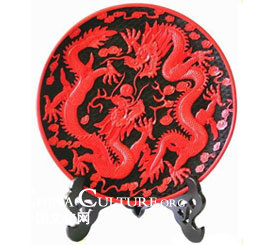Beijing Lacquer Carving
Beijing’s carved lacquer ware is one of China's traditional arts and crafts. The lacquer ware is decorated with exquisite engravings, has a radiant luster, elegant shape, and the pieces are usually resistant to humidity, erosion and heat. . The technique involves applying a natural lacquer on a wooden surface, then engraving delicate designs on the lacquer.

The ancient craftsmanship of carved lacquer originated in the Tang Dynasty (618-907) in today's Sichuan and Yunnan provinces. The Song Dynasty (960-1279) saw the rapid development of the technique. It was in the Yuan Dynasty (1271-1368) that the carved lacquer ware was introduced to Beijing, when the city was designated as the country's capital and attracted many craftsmen. In the early Ming Dynasty (1368-1644), the Orchard Factory, an imperial lacquer workshop, was set up to satisfy the increasing demand of carved lacquer wares from the royal court. Skilled lacquer workers from all over the country gathered in the factory and through competing and cooperating with each other, and they worked out the unique characteristics of Beijing carved lacquer ware. The Qing Dynasty (1644-1911) also had its own imperial workshop specializing in the manufacture of carved lacquer wares. The industry reached its peak during the Qianlong reign, as the emperor himself was an enthusiast who had his coffin decorated with carved lacquer. Yet, the industry declined as the Qing Dynasty entered its final period. At the celebration of Empress Dowger Cixi's 60th birthday, there were already not enough craftsmen left to work on the necessary lacquer wares.
The first commercial workshop of carved lacquer wares, "Ji Gu Zhai", appeared in 1904, set up by Xiao Le'an and Li Maolong, who saved this ancient craft from extinction. After the founding of the People's Republic of China, the Beijing government organized the heirs of Ji Gu Zhai and set up a Beijing Carved Lacquer Factory, the only manufacturer of carved lacquer wares.
However, nowadays, the ancient industry is again on the brink of extinction.
Beijing carved lacquer ware requires a complicated manufacturing process, which starts with a brass or wooden body. After preparation and polishing, it is coated with several dozen of layers of lacquer, reaching a total thickness of 5 to 18 millimeters. Engravers have to wait for the lacquer to dry naturally so it won't crack in the future. Then, engravers will cut into the hardened lacquer, creating "carved paintings" of landscapes, human figures, flowers and birds. It is then finished by drying and polishing. It usually takes 6-8 months to finish a piece of carved lacquer ware.
The complicated manufacturing process and the high production cost have resulted in the high price of the carved lacquer ware, and consequently a decreasing demand for it on the market. The Beijing carved lacquer ware industry has seen a rapid decrease since the 1980s. Young people are reluctant to learn the skills of lacquer-carving, and many elders in the business have passed away. There are only about 20 skilled craftsmen left.
|

